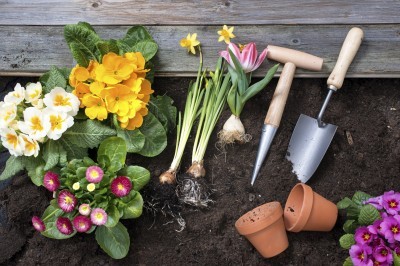
If you’ve never gardened before, you might feel both excited and overwhelmed. You have probably browsed through plant books, spent hours gazing at yummy seed catalogs and roamed the aisles of all your favorite local nurseries salivating over all those pretty plants. You imagine a gorgeous garden where you can entertain your friends and family.
But where do you begin? You know it can be a lot of work and you wonder how to make gardening easier than everyone says it is. What are the best time saving tips for gardeners? Read on to learn more.
How to Make Gardening Easier
The best gardening ideas for beginners require you to slow down, proceed methodically and get organized. That may not sound like much fun, but it will be worth it in the long run. The slow-go approach will save money and time.
- Start with a plan. Measure the area you want to landscape. Create a little sketch. Which areas will be paths and which areas will be planting beds? Draw them out. The plan doesn’t have to be perfect. Assess your sun and shade patterns. Find out your climate zone from your local nursery and choose only plants that fit your situation.
- Lean toward mass planting. Find foundation shrubs or ground covers you really love and plant them in large masses. Repeat each mass grouping of plants at least 3 times in the landscape so it looks cohesive. You’ll have a simpler, less busy plant palette but it will be more serene. This is a great time saving garden maintenance tip.
- Hydrozone. Place plants that have similar moisture requirements together. This will save you time and money whether you plan to install a drip irrigation system or hand water the entire landscape.
- Concentrate on evergreen and perennial plants. These are low-maintenance plants that come back each year so you won’t have to replant large areas every spring.
- Choose low maintenance plants. This may be hard to do if you are new to gardening. Ask your garden loving friends and your local nursery about plants that are beautiful, yet don’t require too much deadheading, cutting back, fertilizing, spraying, staking, etc. Watch out for plants that reseed aggressively.
- Keep your tools close to your garden. Make sure your tools are easy to access and stored together. Build or buy an attractive tool shed or tool storage area so you don’t have waste time going back and forth between tools and plants.
- Utilize power tools for big or frequent jobs. Use power enhanced hedge trimmers, bulb augers, hole digging tools, tillers, etc.
- Weed wisely. Weed when the soil is moist. For tiny little weeds that form mats, you can lift large patches with a transfer shovel and turn them upside down on end. Catch those weeds when they are small so you have to do less hauling.
- Compost as much as possible. Add compost to your planting beds annually. Compost builds healthy soil that is more resistant to disease. Compost helps your soil hold on to the moisture it needs and also help shed excess soil moisture from heavy rains. Compost increases soil fertility naturally.
- Top dress your planting beds with mulch or bark. Add 3” of disease free mulch to your planting beds to protect the soil from erosion and desiccation. Mulch helps suppress weeds. Do not bury the root crown or lower stem of your tree trunks though.






